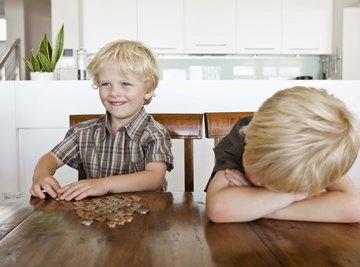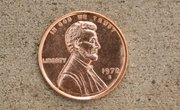
You can perform simple experiments with coins to demonstrate how corrosion occurs and teach kids some basic science principles. These experiments can be done at science fairs or in the classroom to show what causes the metal coating on pennies to corrode. The experiments can demonstrate in interesting and memorable ways how this natural process occurs.
Theory
Coin corrosion experiments explain the theory of oxidation to kids in a visual way that they can understand. The dull, rusty color seen on old pennies is called copper oxide, and it develops because of a reaction of oxygen in the air with the copper on the surface of the pennies. Acidic substances such as vinegar, lemon juice, orange juice and even soda can clean the copper oxide from the pennies because the acid reacts with the copper oxide.
Soda Corrosion Experiment
Most kids love to drink soda. A very simple coin experiment using different types of soda from dark cola to light lemonade can teach children the effect that soda can have on their teeth if they drink too much of it. The theory is that dark sodas like cola are more corrosive than the lighter sodas. Rusty coins can be left in small plastic cups of the different types of soda for a week or so. The kids can take the coins out each day and inspect them. They can write down any changes and document them with digital photographs while observing which type of soda corrodes the rust the fastest.
Salt and Vinegar Experiment
This experiment is visually interesting to kids as the rust can be seen coming off the coins very quickly. It can also be used to explain deeper scientific theories concerning atoms and electrons to more advanced kids. Mix a quarter-cup of white vinegar and a teaspoon of salt into a clear bowl and dip a rusty penny halfway into the solution for a few seconds to see the tarnish comes off from half of the penny. Dump about 20 old pennies in the solution and remove them after five minutes and observe the difference. The solution should have changed color. You can take the experiment further and place two clean nails in the same solution, one halfway in and half out and the other completely submerged. After about 10 minutes, you can get the kids to note the difference in the look of the nails and try to figure out why the changes happened based on their scientific knowledge.
Considerations
It is important to teach kids about all aspects of safety in any scientific experiment. Protect their eyes from acidic solutions by getting them to wear safety goggles and protect their clothes with lab coats or appropriate aprons. Encourage them to wash their hands thoroughly after completing the experiment and clean up in a responsible manner.
References
About the Author
Adelaide Damoah has been writing since 1995. Her work appears on eHow and she has experience with academic writing, web content, newsletters and news releases. Her expertise includes health and art. Damoah holds a Bachelor of Science in applied biology from Kingston University.
Photo Credits
Jupiterimages/Goodshoot/Getty Images
